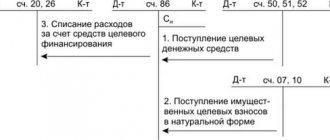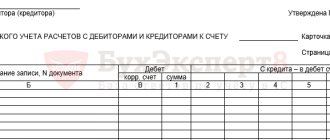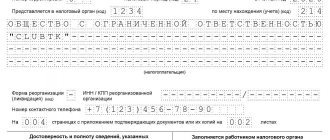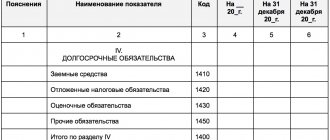Introductory information
The current legislation does not contain clear definitions of the concepts of “targeted funds” and “targeted revenues”. However, Article 251 of the Tax Code establishes closed lists of income that can be classified as targeted financing and targeted revenues. It is necessary to remember that specialists of the Ministry of Finance are guided by the legal position according to which Article 251 of the Tax Code of the Russian Federation contains an exhaustive list of income that is not taken into account when determining the tax base for income tax (for example, letters of the Ministry of Finance of Russia dated August 16, 2011 No. 03-03-05 /88, dated 06/01/11 No. 03-03-06/4/62). Therefore, any attempt at an expanded interpretation of the lists of targeted financing and targeted revenues may lead to a dispute with the tax authority.
The procedure for filling out balance sheet liabilities
The revaluation is reflected - D-t 01.04 K-t 83. The amount of depreciation during revaluation is D-t 83 K-t 02.05.
of additional capital is entered in line 1350 ( account 83).
The share premium of the joint-stock company is indicated here (amounts received in excess of the par value of the company's outstanding shares - D-t 51 K-t 83); as well as the amount of exchange rate differences when forming the authorized capital in foreign currency (D-t 75 K-t 83).
Line 1360 reflects the amount of reserve capital ( account 82) , created both in accordance with the law and in accordance with the constituent documents at the expense of retained earnings (Dt 84 Kt 82). Federal Law “On Joint Stock Companies” requires Russian joint stock companies to create a reserve fund, the size of which cannot be less than 5% of the authorized capital. Joint stock companies must annually contribute at least 5% of their net profit to this fund. In accordance with the constituent documents, reserve capital is formed if its formation is provided for by the constituent documents and accounting policies.
Line 1370 indicates the balance of retained earnings (uncovered loss)
both for previous and reporting periods
(account balance 84
). This line in the annual balance sheet reflects the debit or credit balance on account 84. The interim balance sheet on line 470 reflects the balance on accounts 84 and 99 “Profits and losses”. When drawing up the annual balance sheet, it is reformed, and account 99 is closed - D-t 99 (84) K-t 84 (99).
The amount of the uncovered loss is indicated in the balance sheet in parentheses, and is deducted when calculating the total amount of section 3 of the balance sheet.
A breakdown of the composition of the authorized, additional and reserve capital, as well as retained earnings is given in the Statement of Changes in Capital.
Non-profit organizations in the section “Capital and reserves” instead of the articles “Authorized capital”, “Reserve capital” and “Retained earnings (uncovered loss)” include a group of articles “Targeted financing”, i.e. they show the balances of received and unused target funds (account 86 “Targeted financing) –
entrance, membership, voluntary contributions, as well as targeted funds from other sources. Data on the balances and movement of funds for targeted financing are provided by non-profit organizations in the Report on the targeted use of funds received" (Form No. 6).
Commercial organizations reflect the amounts of target funds on line 640 “Deferred income”. Gradually, as these funds are used for certain purposes (release of inventories for production, depreciation, etc.), these costs are recognized as other income and are subject to income tax.
Received target funds are reflected by commercial organizations in accordance with the requirements of PBU 13/2000 “Accounting for State Aid”.
Date added: 2016-11-02; ;
Types of targeted funds and revenues
Special-purpose financing. Funds of targeted financing include property received by the taxpayer and used by him for its intended purpose, which is determined by the source of targeted financing (organization or individual), as well as by the legislation of the Russian Federation.
The main types of targeted financing of budgetary institutions include the following types of income:
- limits on budgetary obligations (budget allocations);
- subsidies provided by the budget system of the Russian Federation;
- funds received by medical organizations (except for government institutions) carrying out medical activities in the compulsory health insurance system, with the exception of medical services to insured persons from insurance organizations providing compulsory medical insurance to these persons.
Targeted funding in the form of limits on budget obligations (budget allocations) can be provided to government institutions.
Budgetary and autonomous institutions, on the basis of paragraph 1 of Article 78.1 of the Budget Code, from budgets of different levels may be provided with subsidies for reimbursement of regulatory costs associated with the provision by them in accordance with the state (municipal) assignment of state (municipal) services (performance of work), as well as subsidies for other goals.
Targeted revenues. Targeted revenues that are not taken into account when taxing profits are understood as revenues used for the intended purpose for the maintenance of non-profit organizations and the conduct of their statutory activities, received free of charge or on the basis of decisions of authorized bodies, or from other organizations and (or) individuals.
This type of targeted income such as donations deserves special attention. According to paragraph 1 of Article 582 of the Civil Code, a donation is the gift of a thing or right for generally beneficial purposes. Donations can be made to citizens, institutions (medical, educational, charitable, scientific and educational, related to social protection, culture, etc.), foundations, museums, public, religious and other non-profit organizations in accordance with the law, as well as to the state and other subjects of civil law specified in Article 124 of the Civil Code.
The concept of targeted financing
Definition 1
Targeted financing is a type of assistance to an enterprise that is provided by various organizations or the state at the expense of budget funds for the implementation of certain programs.
Targeted financing programs can be of various types:
- Social development of a region or an individual enterprise.
- Programs that promote economic growth.
- Innovative development programs.
- Investment programs.
- Environmental conservation programs.
- Programs for the development of foreign economic activity.
- Programs to eliminate the consequences of natural disasters.
When preparing a target program, the essence and nature of the problem for the solution of which targeted funding is allocated are taken into account. The programs also indicate the timing of the program, the stages of its implementation and a list of all necessary resources to fulfill the program’s objectives (monetary, labor, material). If the implementation of the program requires the participation of third-party organizations, then such target program must indicate such participants and the degree of their participation in the implementation of the project.
Can not understand anything?
Try asking your teachers for help
Tax accounting of target funds and revenues
When taxing profits, funds for targeted financing are not taken into account (clause 14, clause 1 of Article 251 of the Tax Code of the Russian Federation), as well as targeted revenues (clause 2 of Article 251 of the Tax Code of the Russian Federation). Detailed lists of income that can be classified as targeted financing and targeted revenue are contained in Article 251 of the Tax Code of the Russian Federation.
In addition to the above types of revenues, budgetary and autonomous institutions can be provided with two types of subsidies from the budgets: for reimbursement of regulatory costs associated with the provision of state (municipal) services (performance of work) in accordance with the state (municipal) assignment; subsidies for other purposes.
Subsidies of the first type are not taken into account in income, since subclause 14 of clause 1 of Article 251 of the Tax Code of the Russian Federation can be applied to them. Let us note that this position is supported by the Russian Ministry of Finance in letter dated November 29, 2010 No. 03-07-11/458. But speaking in the same letter about subsidies for other purposes, financial department specialists note that the procedure for accounting for them when taxing profits depends on the legal qualification of the purposes for which the subsidies were allocated.
The rule that allows budget subsidies to be classified as targeted financing is given in the letter of the Ministry of Finance of Russia dated May 30, 2011 No. 03-07-11/151. It sounds like this: the activities of an institution, the financial support of which is provided through subsidies from the budgets of the budgetary system of the Russian Federation, must be carried out in accordance with the state assignment. Only in this case, subsidies allocated to such institutions for other purposes are not taken into account in income when determining the tax base for income tax on the basis of subparagraph 14 of paragraph 1 of Article 251 of the Tax Code of the Russian Federation.
In what order do commercial organizations use account 86 “Targeted financing”
Account 86 reflects the receipt and use of targeted funding. The most common types of targeted financing for commercial organizations are:
- subsidies from budgets (including budgets of extra-budgetary funds) to finance current and capital expenditures;
- investor funds for the construction of facilities (from developer organizations).
Please note that the following do not apply to targeted financing:
- budget investments, as a result of which the authorized (share) capital of the organization receiving them increases. In terms of economic content, this is payment for the placed shares (shares, shares);
- subsidies to unitary enterprises for capital investments, as a result of which the authorized capital of the organization receiving them increases. In terms of economic content, this is similar to a contribution to the authorized capital;
- subsidies to compensate for lost income in connection with the sale of goods, performance of work, provision of services to certain categories of citizens at preferential prices (tariffs) or government regulation of prices (tariffs). In terms of its economic content, this is part of the revenue from the provision of services (Letter of the Ministry of Finance of Russia dated July 4, 2018 N 07-01-09/46266).
How to take into account budget subsidies on account 86
Budget subsidies for financing current and capital expenses should be reflected in accounting according to the rules of PBU 13/2000 “Accounting for state aid” (clause 4 of PBU 13/2000). To do this, set in your accounting policy:
- How will you recognize budget funds:
– when there is confidence in their receipt (clauses 5, 7 of PBU 13/2000);
– upon actual receipt of budget funds (clause 7 of PBU 13/2000);
- the procedure for accounting for budgetary funds provided to finance expenses incurred in previous reporting periods:
– without using account 86, as provided for in clause 10 of PBU 13/2000;
– using account 86. We recommend choosing this option, since the use of account 86 will significantly facilitate the formation of information on state aid in the financial statements (for example, Table 9 “State aid”).
In accounting, depending on the provisions of the accounting policy, the following entries are possible:
| Contents of operations | Debit | Credit | Primary document | Base |
| Budget funds are recognized when it is certain that they will be received | ||||
| Funds received to finance upcoming expenses | ||||
| The amount of the allocated subsidy to finance expenses is reflected | 76 | 86 | Subsidy Agreement, Accounting Certificate | Clauses 5, 7 PBU 13/2000 |
| Budget funds received | 51 | 76 | Bank account statement | Clause 7 PBU 13/2000 |
| Budget funds are used to finance expenses (materials, fixed assets, work, services purchased, wages accrued, etc.) | 86 | 98-2 | Accounting information | Clause 9 PBU 13/2000 |
| Budgetary funds are recognized as part of other income (as depreciation is calculated on fixed assets, materials are released into production, etc.) | 98-2 | 91-1 | Accounting certificate-calculation | Clause 9 PBU 13/2000 |
| Funds received to finance expenses already incurred (account 86 is not used) | ||||
| The amount of the allocated subsidy to finance expenses is reflected | 76 | 91-1 | Subsidy Agreement, Accounting Certificate | Clause 10 PBU 13/2000 |
| Budget funds received | 51 | 76 | Bank account statement | Instructions for using the Chart of Accounts |
| Funds received to finance expenses already incurred (account 86 is used) | ||||
| The amount of the allocated subsidy to finance expenses is reflected | 76 | 86 | Subsidy Agreement, Accounting Certificate | Instructions for using the Chart of Accounts |
| The subsidy amount is recognized as other income | 86 | 91-1 | Accounting information | Clause 10 PBU 13/2000, clause 7 PBU 9/99 “Income of the organization” |
| Budget funds received | 51 | 76 | Bank account statement | Instructions for using the Chart of Accounts |
| Budgetary funds are recognized upon actual receipt | ||||
| Funds received to finance upcoming expenses | ||||
| Reflects the amount of budget subsidy received to finance expenses | 51 | 86 | Subsidy agreement, Bank account statement | Clause 7 PBU 13/2000 |
| Budget funds are used to finance expenses (materials, fixed assets, work, services purchased, wages accrued, etc.) | 86 | 98-2 | Accounting information | Clause 9 PBU 13/2000 |
| Budgetary funds are recognized as part of other income (as depreciation is calculated on fixed assets, materials are released into production, etc.) | 98-2 | 91-1 | Accounting certificate-calculation | Clause 9 PBU 13/2000 |
| Funds received to finance expenses already incurred (account 86 is not used) | ||||
| Reflects the amount of budget subsidy received to finance expenses | 51 | 91-1 | Subsidy agreement, Bank account statement | Clauses 7, 10 PBU 13/2000 |
| Funds received to finance expenses already incurred (account 86 is used) | ||||
| Reflects the amount of budget subsidy received to finance expenses | 51 | 86 | Subsidy agreement, Bank account statement | Instructions for using the Chart of Accounts |
| The subsidy amount is recognized as other income | 86 | 91-1 | Accounting information | Clause 10 PBU 13/2000, clause 7 PBU 9/99 |
How to account for investor funds on account 86
If you are a developer building a fixed asset partly for yourself and partly for investors, then take into account the funds received from investors as part of the target financing. This is provided for in paragraphs. “d” clause 3 of the Regulations on Accounting for Long-Term Investments.
Make the following entries in your accounting:
| Contents of operations | Debit | Credit | Primary document |
| The receipt of targeted investment funds for the construction of facilities is reflected | 51 | 76 | Bank account statement |
| Received funds were taken into account as part of targeted financing | 76 | 86 | Investment agreement, Accounting certificate |
| The transfer of the constructed facility to the investor is reflected (as well as the “input” VAT due to the investor under the consolidated invoice) | 86 | 08-3, 19 | Certificate of acceptance and transfer of the object, Consolidated invoice |
Tax accounting of donations
According to subparagraph 22 of paragraph 1 of Article 251 of the Tax Code of the Russian Federation, when calculating income tax, income in the form of property received free of charge for the conduct of statutory activities is not taken into account. And paragraph 2 of Article 251 of the Tax Code of the Russian Federation states that when determining the tax base, targeted revenues are not taken into account (with the exception of targeted revenues in the form of excisable goods), among which donations are also named.
In addition to donations in the form of property (including cash), donations can be in the form of gratuitous work, but provided that the results of the work are used in accordance with their intended purpose. According to Article 5 of the Federal Law of September 11, 1995 No. 135-FZ “On Charitable Activities and Charitable Organizations,” charitable donations can be expressed in the form of disinterested (free of charge or on preferential terms) performance of work, provision of services by philanthropists - legal entities in the interests of the beneficiary. In our opinion, this means that performing work for free can be regarded as a donation.
It should be noted here that a gratuitous agreement is an agreement under which one party undertakes to provide something to the other party without receiving payment or other consideration from it (Clause 2 of Article 423 of the Civil Code of the Russian Federation). Consequently, the contract must necessarily indicate that it is a donation, otherwise it will be considered compensated.
Accounting for target revenues
Most of the funds (property, rights) received by state (municipal) institutions for tax accounting purposes can be qualified as targeted revenues (targeted financing).
The need for separate accounting of target funds and revenues for tax accounting purposes is provided for in subparagraph 14 of paragraph 1 of Article 251 of the Tax Code of the Russian Federation, paragraph 2 of Article 251 of the Tax Code of the Russian Federation. The Ministry of Finance reminded about this need in the letter of the Ministry of Finance of Russia dated 03/05/12 No. 03-03-06/4/18. In the absence of separate accounting of target funds and revenues, this business transaction is subject to taxation from the date of receipt of income.
The instructions for the use of the Unified Chart of Accounts (approved by Order of the Ministry of Finance of Russia dated December 1, 2010 No. 157n, hereinafter referred to as Instruction No. 157n) provide certain tools for organizing separate accounting of income and expenses in the context of certain types of target funds. According to paragraph 21 of Instruction No. 157n, when generating an account number code in the 18th category, accounting entities indicate codes for the type of financial support (1 - budgetary activity; 2 - income-generating activity, etc.).
Reflection of donations in accounting.
Let's look at accounting for target revenues in accounting using the example of donations.
Example
As part of its charitable activities, a construction organization repaired a playground in a preschool institution free of charge. The cost of repair work on the playground, carried out by the organization as part of charitable activities, should be reflected in the debit of account 2 401 20 225 “Expenses for work, property maintenance services” and the credit of account 2 401 10 180 “Other income” using account 2 205 81 000 “Settlements with payers for other income.”
1. The repair of the playground, provided free of charge, is reflected: Dt 2,205 81,560 “Increase in accounts receivable for other income” Kt 2,401 10,180 “Other income” Dt 2,401 20,225 “Expenses for work, property maintenance services” Kt 2,302 25 730 “Increase in accounts payable for work, property maintenance services”
The basis for reflecting this operation are such primary documents as the Certificate of Acceptance of Work Completed and the Certificate of Cost of Work Completed and Expenses.
2. Calculations for repairs are reflected: Dt 2 302 25 830 “Reduction of accounts payable for work, services for property maintenance. Kt 2,205 81,660 “Reduction of accounts receivable for other income.”
In what order do non-profit organizations use account 86 “Targeted financing”
In account 86, non-profit organizations (NPOs) reflect the receipt and use of targeted funding - funds received for the conduct of statutory non-profit activities. Targeted funding for NPOs, in particular, includes:
- budget subsidies;
- entrance, membership, target, additional contributions of founders (participants, members);
- voluntary property contributions of founders;
- donations;
- profit from income-generating activities;
- property received by will through inheritance.
Receipt of targeted financing
Reflect the receipt of funds for targeted financing in the credit of account 86. We recommend that you fix the date on which you will recognize the targeted financing coming to you (except for profit from income-generating activities) in the accounting policy (clause 4, 7.1 of PBU 1/2008).
The following options are possible:
- on the date of receipt of funds or other property (Letter of the Ministry of Finance of Russia dated 02/08/2002 N 16-00-14/41).
This option is suitable for contributions and other mandatory and voluntary payments, until the actual receipt of which the NPO is not sure of their receipt.
When using this option, we recommend organizing analytical accounting on account 86 by periods for which mandatory payments are transferred (for example, membership fees);
- on the date of accrual of membership fees and other mandatory and voluntary payments, regardless of their actual receipt (clause 15 of Information of the Ministry of Finance of Russia PZ-1/2015).
With this option, recognize in accounting the due amounts of obligatory payments (donations) as part of targeted financing on the date of occurrence of obligations to make them, while simultaneously recognizing receivables.
We recommend using this option if there is confidence in receiving funds and (or) other property. This method can be chosen, for example:
– primary trade union organizations, whose members submit applications to the accounting department of the employing organization to withhold membership fees and transfer them to the account of the trade union organization;
– NPOs that receive donations under agreements obliging the donor (clause 1 of Article 582, clauses 1, 2 of Article 572 of the Civil Code of the Russian Federation).
In the accounting of a non-profit organization, taking into account the provisions of the accounting policy, the following entries are possible:
| Contents of operations | Debit | Credit | Primary document | Base |
| Funds are recognized on the date of receipt | ||||
| The receipt of targeted funding (donations, contributions, etc.) is reflected. | 51 (50, 10, etc.) | 86 | Bank account statement (Cash receipt order, Shipping documents of the transferring party, etc.) | Letter of the Ministry of Finance of Russia dated 02/08/2002 N 16-00-14/41 |
| Funds are recognized on the accrual date | ||||
| Due donations, contributions, etc. proceeds are reflected as part of targeted financing | 76 | 86 | Documents confirming the right to receive funds, Accounting certificate | Instructions for using the Chart of Accounts |
| The receipt of targeted funding (donations, contributions, etc.) is reflected. | 51 (50, 10, etc.) | 76 | Bank statement on the current account (Cash receipt order, Shipping documents of the transferring party, etc.) | Instructions for using the Chart of Accounts |
Accounting for profit from income-generating activities
Regardless of the option used by the organization for accounting for membership fees and other mandatory and voluntary payments, reflect profit from income-generating activities as part of targeted financing on the credit of account 86:
- in correspondence with account 84 “Retained profit (uncovered loss)” on the date of profit distribution , if you are an NPO that distributes the profit received (clause 3.8 of the Recommendations for accounting and reporting in agricultural consumer cooperatives, Letter of the Ministry of Finance of Russia dated July 31, 2003 N 16-00-14/243). This accounting procedure can be used, for example, by consumer cooperatives (clause 1 of article 24 of the Law of the Russian Federation of June 19, 1992 N 3085-1);
- in correspondence with account 99 “Profits and losses” with the final turnover of December of the reporting year - for all other non-profit organizations (clause 24 of Information of the Ministry of Finance of Russia PZ-1/2015).
Reflect the recognition of profit as part of target financing with the following entries:
| Contents of operations | Debit | Credit | Primary document | Base |
| If the organization distributes the profit received | ||||
| Profit from income-generating activities is aimed at increasing targeted funding | 84 | 86 | Decision on profit distribution, Accounting certificate | Recommendations for accounting and reporting in agricultural consumer cooperatives, Letter of the Ministry of Finance of Russia dated July 31, 2003 N 16-00-14/243 |
| If the organization does not distribute the profits received | ||||
| Profit from income-generating activities is recognized as a source of targeted financing | 99 | 86 | Accounting information | Clause 24 of Information of the Ministry of Finance of Russia PZ-1/2015 |
How to organize accounting and tax accounting of target funds and revenues?
However, to organize reliable accounting of target funds for both accounting and tax accounting purposes, the tools provided for by Instruction No. 157n are not enough. Therefore, the accounting policy of a state (municipal) institution must provide tools for organizing separate accounting of transactions carried out with property (including cash), the receipt of which was previously qualified as a target for tax and (or) accounting purposes. Such tools include:
- use of additional codes when generating analytical accounts (by introducing an additional digital code into the account number);
- organization of accounting in the context of certain analytical indicators;
- organization of additional off-balance sheet accounting.
Reporting on the use of targeted funds and proceeds
Organizations that have received targeted funding, targeted revenues and other funds specified in paragraphs 1 and 2 of Article 251 of the Tax Code of the Russian Federation must submit to the Federal Tax Service a “Report on the targeted use of property (including funds), works, services received as part of charitable activities , targeted revenues, targeted financing” - sheet 07 of the Income Tax Declaration.
Codes of types of income for filling out sheet 07 of the Declaration are given in Appendix No. 3 to the Procedure for filling out a tax return for income tax (approved by order of the Federal Tax Service of Russia dated March 22, 2012 No. ММВ-7-3 / [email protected] ). In addition, for income in the form of work (services) received free of charge by non-profit organizations, performed (rendered) on the basis of relevant contracts, the type of income code is 130.
This report does not include funds in the form of limits on budgetary obligations (budgetary allocations) communicated in the prescribed manner to government institutions, as well as in the form of subsidies provided to budgetary and autonomous institutions (clause 15.1 of the Procedure for filling out sheet 07 of the Income Tax Declaration).
Targeted financing and receipts in the balance sheet: line
The balance sheet does not provide a separate line to reflect funds received for the intended purpose, since they are not formed into a reserve, but work, diverging into corresponding accounts.
Targeted financing in the balance sheet can be reflected in line 1530 “Deferred income” or as a separate item in the section of short-term liabilities in line 1520 “Accounts payable” if the transferred funds must be returned (for example, due to the inability to use them). When an investment is received for the purchase of fixed assets and its subsequent development, the amount of the company’s additional capital increases (line 1350). All information about the availability and use of targeted financing must be disclosed in the notes to the statements. Non-profit organizations report additionally, drawing up a special report form “On the intended use of funds.”
Thus, targeted financing in the balance sheet is reflected in several positions and a complete picture of its volume of receipts and expenditures can be seen only in the explanations to the statements.
Targeted financing on the balance sheet: an example
In February 2019, the enterprise was allocated a Central Fund from the local budget for the purchase of new equipment - 3 million rubles:
Incoming funds received:
The OS object was purchased and put into operation at the expense of the Fund:
D/t 01 K/t 08 in the amount of 3 million rubles.
The intended use of funds is reflected by the posting:
D/t 86 K/t 98 for the amount of 3 million rubles.
At the end of the reporting period, the amount of the financial fund will be reflected in the balance sheet on line 1530 as part of deferred income.
If the company cannot use the funds received for their intended purpose, it will be obliged to return them. At the same time, accounts payable arises under the Financial Fund (D/t 86 K/t 76), and if at the time of drawing up the balance sheet it is not transferred to the budget, then the targeted financing will be reflected in the balance sheet line 1520 “Accounts payable”.
| Indicator name | Code | Which account data is used? | Algorithm for calculating the indicator |
| Intangible assets | 1110 | 04 “Intangible assets”, 05 “Amortization of intangible assets” | D04 (excluding R&D expenses) – K05 |
| Research and development results | 1120 | 04 | D04 (in terms of R&D expenses) |
| Intangible search assets | 1130 | 08 “Investments in non-current assets”, 05 | D08 – K05 (all regarding intangible exploration assets) |
| Material prospecting assets | 1140 | 08, 02 “Depreciation of fixed assets” | D08 – K02 (all regarding material exploration assets) |
| Fixed assets | 1150 | 01 “Fixed assets”, 02 | D01 – K02 (except for depreciation of fixed assets accounted for in account 03 “Income-generating investments in tangible assets” |
| Profitable investments in material assets | 1160 | 03, 02 | D03 – K02 (except for depreciation of fixed assets accounted for on account 01) |
| Financial investments | 1170 | 58 “Financial investments”, 55-3 “Deposit accounts”, 59 “Provisions for impairment of financial investments”, 73-1 “Settlements on loans provided” | D58 – K59 (in terms of long-term financial investments) + D73-1 (in terms of long-term interest-bearing loans) |
| Deferred tax assets | 1180 | 09 “Deferred tax assets” | D09 |
| Other noncurrent assets | 1190 | 07 “Equipment for installation”, 08, 97 “Deferred expenses” | D07 + D08 (except for exploration assets) + D97 (in terms of expenses with a write-off period of more than 12 months after the reporting date) |
| Reserves | 1210 | D10 + D11 – K14 + D15 + D16 + D20 + D21 + D23 + D28 + D29 + D41 – K42 + D43 + D44 + D45 + D97 (for expenses with a write-off period of no more than 12 months after the reporting date) | |
| Value added tax on purchased assets | 1220 | 19 “Value added tax on acquired assets” | D19 |
| Accounts receivable | 1230 | 46 “Completed stages of work in progress”, 60 “Settlements with suppliers and contractors”, 62 “Settlements with buyers and customers”, 63 “Provisions for doubtful debts”, 68 “Settlements for taxes and duties”, 69 “Settlements for social insurance and security", 70 "Settlements with personnel for wages", 71 "Settlements with accountable persons", 73 "Settlements with personnel for other operations", 75 "Settlements with founders", 76 "Settlements with various debtors and creditors" | D46 + D60 + D62 – K63 + D68 + D69 + D70 + D71 + D73 (except for interest-bearing loans accounted for in subaccount 73-1) + D75 + D76 (minus VAT calculations reflected in the accounts on advances issued and received) |
| Financial investments (excluding cash equivalents) | 1240 | 58, 55-3, 59, 73-1 | D58 – K59 (in terms of short-term financial investments) + D55-3 + D73-1 (in terms of short-term interest-bearing loans) |
| Cash and cash equivalents | 1250 | 50 “Cash”, 51 “Current accounts”, 52 “Currency accounts”, 55 “Special bank accounts”, 57 “Transfers in transit”, | D50 (except for subaccount 50-3) + D51 + D52 + D55 (except for the balance of subaccount 55-3) + D57 |
| Other current assets | 1260 |









